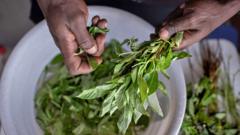In an unexpected turn of culinary events, traditional indigenous leafy vegetables in Kenya, once dismissed as mere "weeds," are rapidly becoming culinary staples across the nation. Often labeled "kienyeji," these native greens are now gracing the menus of bustling restaurants, including the popular Skinners Restaurant in Gachie, which reports a surge in demand for these nutrient-rich options.
Kimani Ng'ang'a, an employee at the restaurant, reveals that local varieties of greens are outselling their colonial counterparts, such as cabbage and kale, despite often coming at a premium due to sourcing difficulties. As more Kenyans seek out organic produce, the health benefits associated with kienyeji, such as detoxification and weight loss, are driving their popularity. "It's all about its taste, which is better," remarked a diner who opted for "managu," or African nightshade.
The revitalization of interest in these local varieties aligns with findings from horticulture professor Mary Abukutsa-Onyango, who highlights a significant doubling in production of indigenous greens over the last decade. In 2022 alone, local farmers generated 300,000 tonnes of these vegetables, signifying a remarkable shift in perception and cultivation practices.
In decades past, traditional crops were often viewed as inferior, overshadowed by imported varieties labeled as "sukumawiki," which means "stretch the week" in Swahili. These exotic greens were introduced during colonial times and became the staple for countless households. Today, however, the re-emergence of interest in nutrient-rich local crops is challenging decades of culinary habits.
Evidence of their nutritional superiority is gaining traction; Professor Abukutsa-Onyango notes that local vegetables such as "mrenda" (jute mallow) and "terere" (amaranth) boast higher essential mineral content compared to the ubiquitous sukumawiki. Interestingly, a mere 100 grams of mrenda may contain more nutrients than the same amount of cabbage. The UN cultural agency, Unesco, recognized Kenya's dedication to preserving this culinary heritage in 2021, acknowledging efforts to catalog indigenous plants and their culinary significance.
Despite these advancements, not all farmers are pleased with current regulations. The government restricts planting uncertified seeds, creating barriers for farmers like Francis Ngiri, who has shifted his operations to practice organic farming of native species in the relatively untouched Rift Valley. While he has grown his collection of local plants through seed exchanges, these practices remain a gray area under the law.
Meanwhile, initiatives from organizations like Seed Savers Network emphasize the importance of maintaining biodiversity by preserving traditional crops, especially as the market increasingly favors exotic varieties. To this day, over 35 traditional plant varieties have vanished in one Kenyan county alone due to restrictive regulations.
In response, Dr. Peterson Wambugu, a chief research scientist, underlines that Kenyan law contradicts international agreements protecting farmers' seed rights. Ongoing discussions around drafting new regulations could pave the way for farmers to exchange seeds legally, although the sale of uncertified seeds would still face opposition.
Ultimately, evidence suggests the trend towards indigenous greens is irreversible. Vendors like Priscilla Njeri in Wangige market note that these local varieties are preferred by consumers, often praised for their superior taste and health benefits. As Kenya embraces its culinary roots, the future looks bright for these once-forgotten weeds, now taking their rightful place at the heart of the dining table.


















